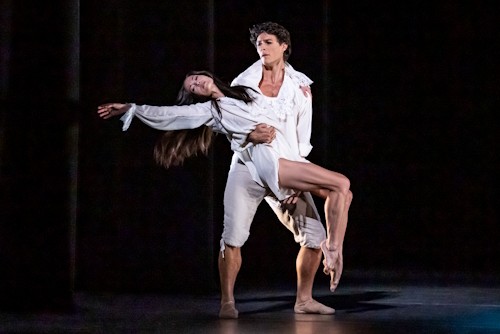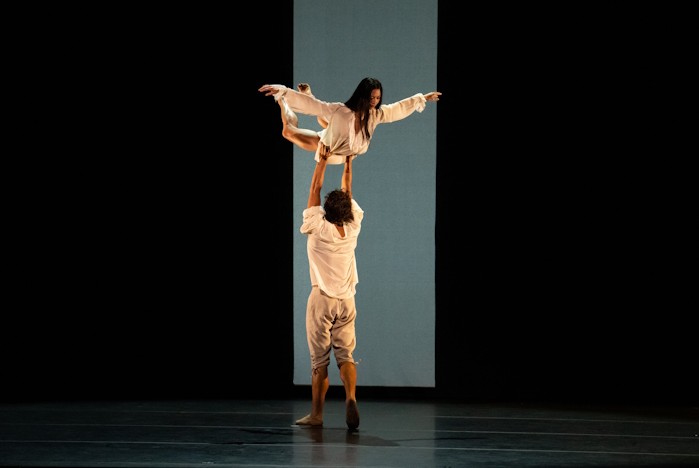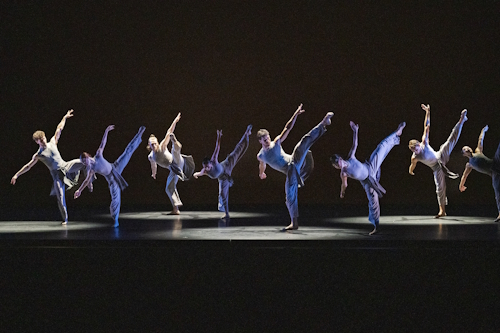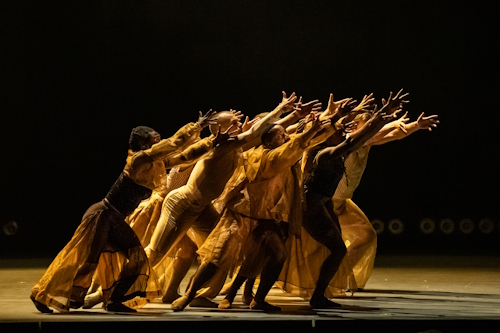September 21, 2025
New York City Center
What went before and after was good, very good, but the heart of this year’s third Fall for Dance programme very much laid in two sublime pas de deux by Hannah O’Neill and Hugo Marchand, visiting from the Paris Opera Ballet. Neither could even remotely be described as showy, both being very private and very personal in their own way.
The opening of the pas de deux from Angelin Preljocaj’s Le Parc simmers with expectation. There’s something alluring about the way he just stands there, about the way she lets her long hair fall over her face, about the way she brushes it back again.

in the pas de deux from Angelin Preljocaj’s Le Parc
Photo Steven Pisano
Is he being cool, uncertain, nervous, regal? I’m not sure. But does it matter? Because as the duet slowly develops there is so much to love. The moment she lays her head on his chest. The way they each in turn runs a hand over the other’s face. The way he gently traces the shape of her breasts. The way they roll over and over in each other’s arms on the floor.
There are a couple of big dramatic moments. Marchand made the long overhead lift look as easy as can be, but most famously there’s the long kiss when he flies her around and around, her feet off the floor, she holding on only with her arms around his neck. But even this comes slowly, the moment of take-off built up to gradually. It feels utterly right, utterly natural.
And then she leaves. O’Neill and Marchand were quite riveting. It was also divine. Quite divine.
O’Neill and Marchand’s second offering, Afternoon of a Faun by Jerome Robbins, is not without its likenesses, not least in the way she arrives with him already inhabiting the space, the initial shyness of the encounter, and the way she leaves alone.
Robbins translates the action to a ballet studio in which both dancers communicate largely through their reflections in the unseen mirrors. It opens with the man, Marchand, stretching. There’s something quite vain, quite narcissistic about the way he looks in the mirror, but also an overwhelming sense of loneliness, perhaps even of sadness. The choreography here quotes from Nijinsky’s original L’Après-midi d’un faune.
O’Neill, who arrives on pointe, is wonderfully pliant. When she plies at the barre, there’s a sense that she’s doing so in a way to attract his attention. When she developpés her leg, she’s fully aware of her appeal and what she’s doing. When the pair finally connected, there was an intense frission.
When she leaves, you sense she wants him to follow. No such luck. Instead, it’s back to where we came started, him stretching, lost in himself.
The programme opened with the Gibney Company in the light and bright Three Dances (for prepared piano) John Cage, a dance of postmodern precision to an intensely rhythmic score by Lucinda Childs.
Watching the dancers move through the precise choreography was a delight. A lot of the work doesn’t just call for accuracy but speed too. The four couples skipped and leapt, those low skidding jumps that barely get off the floor, with ease. True, there is a lot of repetition as sections and phrases repeat and repeat. Yet far from being dull, it engenders a sense of warm familiarity. But there are plenty of variations too, plus a little humour, and even moments of controlled chaos. It was very satisfying.
Rounding things off was the powerful The Missing Fruit (Part I) by Roderick George and kNoname Artist, the Berlin-founded, New York City-based dance company he started ten years ago. The work examines the experiences and struggles of black, indigenous and people of colour, while also making space for joy to thrive.
The title comes from Billie Holiday’s 1939 song ‘Strange Fruit,’ which shone a light on the unrelenting racial and social injustices that took place between the later nineteenth and mid-twentieth centuries in the southern states in particular.
The work sometimes feels quite claustrophobic but elsewhere is expensive and athletic. It opens with the stage bathed in red, a single dancer running in slow-motion, the others rising heavily from the ground. Scenes and partnerships come and go quickly, Geroge having that great knack of knowing just when to move on. Amidst the ensemble sections are some great solos that suggest despair, determination and more, and one fabulous trio. Best comes with the final duet though, a close quarters affair for Joseph Markey and George himself that ends abruptly with a single gunshot, silence, and a body sprawled on the ground.





